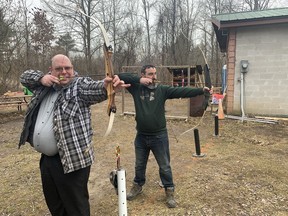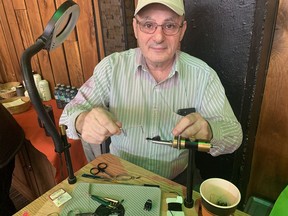
Brantford residents take a lot of ibuprofen.
Advertisement 2
Article content
A 40-pound (18 kg) wolverine can take down a 1,000-pound (454 kg) moose, have it for dinner and enjoy leftovers for a week.
Article content
As for possibility of multiple cougar sightings in Brantford?
Slim, but certainly possible.
Those are just a couple of examples of what could be learned by attending the Brant Rod & Gun Club Eco-Conference on Saturday. The event covered a number of topics and included several speakers including Greg Balch of the Ontario Federation of Anglers and Hunters.
“A large male cougar has a 1,000-square-mile range and just like terrestrial predators they have an elliptical pattern in which they move,” Balch said. “So a cougar could be in Windsor next week, Niagara Falls three months later, Brantford three months after that and in London three months after that.”
Advertisement 3
Article content
Balch has spotted two alive in the wild, including one in May 2009, north of London.
“It was on the 16th concession west of Highbury Avenue and it was sitting in the middle of the road in front of my truck.
“It just got up and wandered off.”
Balch was at the eco-conference to speak about wildlife ecology and brought with him an attention-grabbing trove of stuffed animals including a wolfine, one of his favorites. A wolverine can take down a 1,000-pound moose, he explained.
Others spoke about educational opportunities on the Grand River through eco-tourism and the need to fight climate change.
“An absolutely fantastic day,” said club president Jason Flinders. “Doris Myke is the founder of the conference, she’s a volunteer and I give her full marks for this conference.
Advertisement 4
Article content
“It’s been busy throughout the day and this morning we were standing room only when local dignitaries showed up to make some remarks.”

The conference attracted more than 70 people and close to 20 volunteers helped make it run smoothly, Flinders said.
Located on Henderson Road, the club was formed in 1937. It has a shooting range, archery range and fish hatchery.
The hatchery raises 10,000 brown trout a year starting with eggs received from the Ministry of Natural Resources. The brown trout are then released into the Grand River watershed in the Kitchener area.
Larry Mellors, vice president of Trout Unlimited Middle Grand Chapter, spoke about what vertebrates can tell us about water. He was asked about the impact of pharmaceuticals on the water system.
Advertisement 5
Article content
Mellors said there was a study in Brantford that took a close look at the minnow population in the Grand River that does not migrate.
Scientists took 500 minnows from above the city’s sewage treatment plant and 500 minnows from below the plant. A mobile trailer lab was set up to examine the minnows.
The livers of the minnows were dissected to determine the impact of the sewage treatment plant on the minnows.
“I can say this now,” Mellors said. “No one in Brantford should have a headache, there was so much ibuprofen.

“The other one (pharmaceutical) that was high was birth controlled.”
Mellors encouraged people to monitor the water at their homes or on their properties and to keep the water clean and moving freely.
Removing dams on waterways are crucial to water quality and he encouraged people to get involved in water and ecological protection, Mellors said.
twitter.com/EXPVBall
Article content
